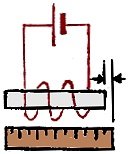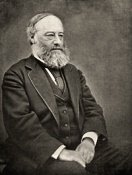Electronics & Technology
- See Full List of AI Topics -

When a nickel rod is magnetized, it becomes shorter in length.
Ultrasonic transducers for sonar employ this principle based upon the magneto-restrictive
effect.
The magnetostrictive effect is a physical phenomenon in which certain materials
change their shape or dimensions when subjected to a magnetic field. This effect
occurs because magnetic field lines interact with the atomic structure of a material,
particularly with its magnetic dipoles, causing a mechanical deformation. Conversely,
when these materials are mechanically deformed, they produce a change in their magnetic
properties. The relationship between magnetism and mechanical deformation is the
essence of the magnetostrictive effect and it plays a significant role in the functionality
of various devices, ranging from sonar systems to sensors.
Discovery and Historical Development
The magnetostrictive effect was first observed by the British physicist James
Joule in 1842. Joule, best known for his work on the conservation of energy and
thermodynamics, noticed that when a ferromagnetic material, such as iron, was placed
in a magnetic field, it experienced slight changes in length. This subtle deformation
of the material in response to magnetism, though small, laid the foundation for
a deeper understanding of the coupling between magnetic fields and mechanical properties
in solids. Over the following decades, various researchers explored the implications
of Joule's discovery, leading to the realization that many ferromagnetic materials
exhibit some form of magnetostriction.

James Prescott Joule
The effect was initially seen as a laboratory curiosity, with little immediate
practical application. However, the early 20th century saw rapid technological advancements,
especially in communication systems, which demanded materials that could efficiently
convert electromagnetic signals into mechanical motion, or vice versa. This need
provided fertile ground for further research into the magnetostrictive effect, eventually
giving rise to devices such as transducers and sensors.
During the mid-20th century, a deeper theoretical understanding of the magnetostrictive
effect was developed. Physicists and material scientists began studying the microscopic
origins of the phenomenon, particularly the alignment of magnetic domains in ferromagnetic
materials. Magnetic domains are small regions within a material where the magnetic
dipoles are aligned in the same direction. When a magnetic field is applied to a
magnetostrictive material, the magnetic domains rotate and realign, which causes
the material to change its shape slightly.
Theoretical Underpinnings
The core of magnetostriction lies in the interaction between the magnetic domains
of a material and an external magnetic field. In ferromagnetic materials, atoms
possess intrinsic magnetic moments due to the spin of electrons and their orbital
motion around the nucleus. In the absence of an external magnetic field, these magnetic
moments or domains are randomly oriented. However, when a magnetic field is applied,
these domains begin to align in the direction of the field. This reorientation results
in a small mechanical strain, as the domain walls shift, leading to a change in
the material's length or shape.
Magnetostriction can be described quantitatively using a magnetostriction coefficient,
which measures the strain produced in the material per unit of applied magnetic
field. The magnetostrictive effect is typically very small, with strains in most
materials on the order of 10^-6 to 10^-5. However, certain materials, such as Terfenol-D,
exhibit much larger strains, making them highly suitable for practical applications.
Terfenol-D is an alloy of terbium, dysprosium, and iron, and it was developed in
the 1970s by the Naval Ordnance Laboratory in the United States as part of military
sonar research.
Applications of the Magnetostrictive Effect
One of the earliest and most significant uses of the magnetostrictive effect
was in sonar systems during World War II. In sonar, underwater sound waves are used
to detect objects such as submarines. Magnetostrictive materials can convert electrical
energy into mechanical vibrations, producing sound waves that travel through water.
These sound waves reflect off underwater objects, and the returning echoes are converted
back into electrical signals by the same or similar magnetostrictive materials.
The robustness of magnetostrictive materials in harsh environments, such as underwater,
makes them ideal for this purpose.
The magnetostrictive effect also plays a crucial role in ultrasonic transducers,
which are devices that generate high-frequency sound waves. These transducers are
widely used in medical imaging, non-destructive testing of materials, and industrial
cleaning. In these applications, the magnetostrictive materials generate vibrations
that produce ultrasonic waves, which can penetrate materials and provide detailed
internal images or cause surface cleaning at the microscopic level.
Another common application is in sensors. Magnetostrictive sensors are used to
measure variables like displacement, force, torque, and pressure. These sensors
operate on the principle that mechanical stress induces changes in the magnetic
properties of a material, which can then be detected and measured. They are highly
valued for their durability, as they have no moving parts, and their precision in
harsh industrial environments.
The magnetostrictive effect also finds applications in the field of actuators.
Magnetostrictive actuators convert magnetic energy into mechanical motion and are
commonly used in precision positioning systems, such as those found in robotics
or aerospace engineering. For instance, actuators that make use of materials like
Terfenol-D can provide very fine movements and are often employed where precise
control of motion is required.
Magnetostrictive materials are employed in power transformers as well. In transformers,
these materials can help reduce noise caused by magnetostriction. This noise, known
as "hum," occurs when the iron core of a transformer experiences cyclic changes
in size as the magnetic field fluctuates with the alternating current. By utilizing
materials with tailored magnetostrictive properties, engineers can mitigate this
unwanted sound and enhance the efficiency and longevity of transformers.
In addition to these industrial applications, magnetostrictive materials have
found use in consumer electronics, such as in audio speakers and vibration alert
systems in mobile phones. For example, in certain high-performance speakers, magnetostrictive
materials are used to convert electrical signals into sound waves, providing high-fidelity
audio output.
Modern Advances and Materials
The quest to develop new and more effective magnetostrictive materials has led
to significant advancements in materials science. In addition to the well-known
materials like Terfenol-D, other materials such as galfenol (an alloy of iron and
gallium) and metglas (metallic glasses) have shown promise. Galfenol, in particular,
is known for its toughness and ability to withstand significant mechanical stress
while still exhibiting substantial magnetostrictive properties. This makes it a
strong candidate for applications in demanding environments where mechanical wear
and fatigue are concerns.
The increasing demand for energy-efficient, durable, and miniaturized devices
has pushed the boundaries of magnetostrictive research. For instance, nanoscale
magnetostrictive materials are being explored for use in microelectromechanical
systems (MEMS). These tiny devices, often used in modern electronics, require precise
control of mechanical motion at the micro- and nano-scale. The use of magnetostrictive
materials in these systems offers a way to achieve that control through magnetic
fields, providing a contactless and energy-efficient means of actuation.
 This content was generated by primarily
the ChatGPT (OpenAI), and/or
Gemini (Google), and/or
Arya (GabAI), and/or
Grok (x.AI), and/or DeepSeek artificial intelligence (AI) engine.
Some review was performed to help detect and correct any inaccuracies; however,
you are encouraged to verify the information yourself if it will be used for critical
applications. In some cases, multiple solicitations to the AI engine(s) was(were) used to assimilate
final content. Images and external hyperlinks have also been added occasionally.
Courts have ruled that AI-generated content is not subject to copyright restrictions,
but since I modify them, everything here is protected by RF Cafe copyright. Many
of the images are likewise generated and modified. Your use of this data implies
an agreement to hold totally harmless Kirt Blattenberger, RF Cafe, and any and all
of its assigns. Thank you. Here are the major categories. This content was generated by primarily
the ChatGPT (OpenAI), and/or
Gemini (Google), and/or
Arya (GabAI), and/or
Grok (x.AI), and/or DeepSeek artificial intelligence (AI) engine.
Some review was performed to help detect and correct any inaccuracies; however,
you are encouraged to verify the information yourself if it will be used for critical
applications. In some cases, multiple solicitations to the AI engine(s) was(were) used to assimilate
final content. Images and external hyperlinks have also been added occasionally.
Courts have ruled that AI-generated content is not subject to copyright restrictions,
but since I modify them, everything here is protected by RF Cafe copyright. Many
of the images are likewise generated and modified. Your use of this data implies
an agreement to hold totally harmless Kirt Blattenberger, RF Cafe, and any and all
of its assigns. Thank you. Here are the major categories.
Electronics & High Tech
Companies | Electronics &
Tech Publications | Electronics &
Tech Pioneers | Electronics &
Tech Principles |
Tech Standards Groups &
Industry Associations | Societal
Influences on Technology
 While working on an
update to my
RF Cafe Espresso Engineering Workbook project to add a couple calculators
about FM sidebands (available soon). The good news is that AI provided excellent
VBA code to generate a set of
Bessel function plots. The bad news is when I asked for a
table
showing at which modulation indices sidebands 0 (carrier) through 5 vanish,
none of the agents got it right. Some were really bad. The AI agents typically
explain their reason and method correctly, then go on to produces bad results.
Even after pointing out errors, subsequent results are still wrong. I do a
lot of AI work and see this often, even with subscribing to professional
versions. I ultimately generated the table myself. There is going to be a
lot of inaccurate information out there based on unverified AI queries, so
beware. While working on an
update to my
RF Cafe Espresso Engineering Workbook project to add a couple calculators
about FM sidebands (available soon). The good news is that AI provided excellent
VBA code to generate a set of
Bessel function plots. The bad news is when I asked for a
table
showing at which modulation indices sidebands 0 (carrier) through 5 vanish,
none of the agents got it right. Some were really bad. The AI agents typically
explain their reason and method correctly, then go on to produces bad results.
Even after pointing out errors, subsequent results are still wrong. I do a
lot of AI work and see this often, even with subscribing to professional
versions. I ultimately generated the table myself. There is going to be a
lot of inaccurate information out there based on unverified AI queries, so
beware.
|











